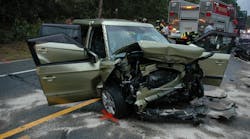Motor vehicle accidents cost employers nearly $57 billion in 2017, according to a recent study release by Motus, a vehicle management and reimbursement platform.
Motus unveiled new research around driver safety in the workplace in recognition of Distracted Driving Awareness month, which is in April. The “2018 Driver Safety Risk Report” finds that the number of auto accidents and injuries remain at record high levels, and 40% of these vehicle accidents are work-related. In all, Motus estimates that motor vehicle crashes cost employers $56.7 billion in 2017.
“Between medical expenses for their employees and others involved in an accident, insurance increases, leave wage replacement and property damage costs, we’re now able to see the true financial impact of accidents on businesses – and it’s shocking,” said Ken Robinson, market research analyst for Motus. “Emphasizing driver safety and protecting mobile employees has always been the right thing to do, but it’s clearly good business practice as well.”
The report also finds that employers have opportunities to reduce the number of accidents among their mobile employees dramatically by expanding their driver risk management approach beyond basic Motor Vehicle Record (MVR) checks. Instituting solutions such as proactive, individualized training and insurance verification can reduce collision rates by as much as 35%.
“While our research paints a startling picture of rising accident frequency and increasing costs, employers should feel empowered knowing they have the ability to sway the trend and quite literally save lives,” said Craig Powell, CEO of Motus. “One way employers can do this is by implementing a fixed and variable rate (FAVR) reimbursement program that accounts for how much employees drive and where they drive during work-related trips only, thereby mitigating exposure to costs associated with off-hour accidents. Reducing risk not only assures employees are conducting their business more safely, it also protects the business’ bottom line.”
Additional findings in the 2018 Driver Safety Risk Report include:
- U.S. collision insurance claims remain at the highest levels of the past 10 years and have steadily increased over the past five years.
- 53 percent of vehicle crash injuries cause employees to miss work.
- When an employee has an accident that includes damage to both a person and a vehicle, their annual insurance rates typically increase by about 33 percent. Accidents without any injuries increase insurance annual rates by about 23 percent. That means that an accident could increase an employee’s average auto insurance costs by $350- $515 a year.
- Only 42.6 percent of companies currently mandate driver safety programs for employees in company-owned vehicle programs. That number drops to just 19.5 percent for employees in mileage reimbursement programs.



